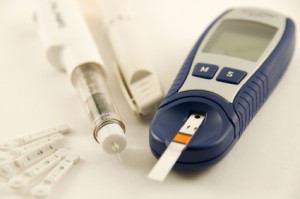November Is National Diabetes Month – Know The Warning Signs
There are two main types of Diabetes: Type 1 and Type 2. Type 2 Diabetes is the most common form with millions of Americans diagnosed, and many more are unaware they are at high risk. In type 2 Diabetes, either the body does not produce enough insulin or the cells ignore the insulin. Insulin is necessary for the body to be able to use glucose for energy. When you eat food, the body breaks down all of the sugars and starches into glucose, which is the basic fuel for the cells in the body. Insulin takes the sugar from the blood into the cells. When glucose builds up in the blood instead of going into cells, it can lead to Diabetes complications. Although the causes of type 2 Diabetes are unknown, there are some key risk factors. These health risk factors can increase your chances of getting this increasingly common type of Diabetes.
Type 2 Diabetes Risk Factors
A person with some or all of the following listed health risk factors may never develop type 2 Diabetes. However, the latest medical findings show that the chances of getting type 2 Diabetes increase the more health risk factors you have.
A family history of Diabetes. If a parent or sibling in your family has diabetes, your risk of developing Diabetes increases.
Age over 45. The chance of getting type 2 Diabetes increases with age.
Race or ethnic background. The risk of type 2 Diabetes is greater in Hispanics, blacks, Native Americans, and Asians.
Being overweight. If you are overweight, defined as a body mass index (BMI) greater than 25, you’re at higher risk of type 2 Diabetes.
Hypertension. High Blood Pressure increases the risk of developing type 2 Diabetes.
Abnormal cholesterol levels. HDL (“good”) cholesterol levels under 35 mg/dL (milligrams per deciliter) and/or a triglyceride level over 250 mg/dL increases your risk of type 2 diabetes.
History of gestational diabetes Getting diabetes during pregnancy or delivering a baby over nine pounds can increase your risk of type 2 diabetes.
To learn more about Diabetes visit:http://www.diabetes.org/
Or to learn more about living life with Diabetes, please visit my friend Kerri’s blog: http://www.sixuntilme.com
or
Amy’s blog at: http://www.diabetesmine.com
-butyoudontlooksick.com staff
Comments (2)




We need to have some more info on type 1. As a type 1 diabetic for the past 23 years, I’m 25 years old, it’s hard to get glanced over.
At the young age of 2 I was diagnosed with type 1 AKA juvenile diabetes. My blood sugar upon diagnosis was 1400, normal range for me now is 100-120. This extreme hyperglycemia caused me to have a stroke and slip into a coma. Things were looking bleak and a priest was called in and gave me my last rights. Luckily, thanks to the amazing doctors and I suppose my will to live I woke up. Unfortunately I did lose a lot of strength on the right side of my body.
Knock on wood I’m still here!!! Now with gastroparesis, paralyzed stomach, from complications of my diabetes.
Type 1 diabetes differs from type 2 in many ways–from the causes of the disease to the course of treatment required. Unlike type 2, which has clear warning signs in a person’s medical records and family history, type 1 is an autoimmune disease that can seemingly come out of nowhere. In type 1, your body’s own immune system creates antibodies that attack and destroy the cells in your pancreas that produce insulin.
Because a type 1 diabetic can’t produce their own insulin anymore, they require some outside source of insulin to live. Some of us use daily injections (in my case, around 4 shots a day), others use a device called an insulin pump to deliver a steady stream of insulin with spikes at meal times when your body would otherwise naturally create more insulin.
Without insulin, your cells can’t use the sugar in your blood and an excess amount of sugar can build up. Most of the early symptoms of type 1 diabetes are related to this build up of blood sugars:
– Weight loss and increased appetite : This was my trigger to go to the doctor. I lost around 20 lbs in a month while feeling like I was starving and eating like a pig. I was consuming plenty of carbs, but my body had no way of using them without insulin. Without the ability to process those carbs for energy, my body was basically starving.
– Increased thirst and frequent urination: With all that excess sugar and no way to use it, your body tries to lower potentially dangerous blood glucose levels through one of the only ways out: pee.
-Change in disposition: This one’s sort of a no brainer. If you’re constantly hungry, thirsty, tired, shrinking and peeing, you’re going to be a bit of a grouch.
– Changes in vision: If you’re hungry, thirsty, tired, shrinking, peeing, grouchy AND you think you need new glasses, get yourself to a doctor ASAP.